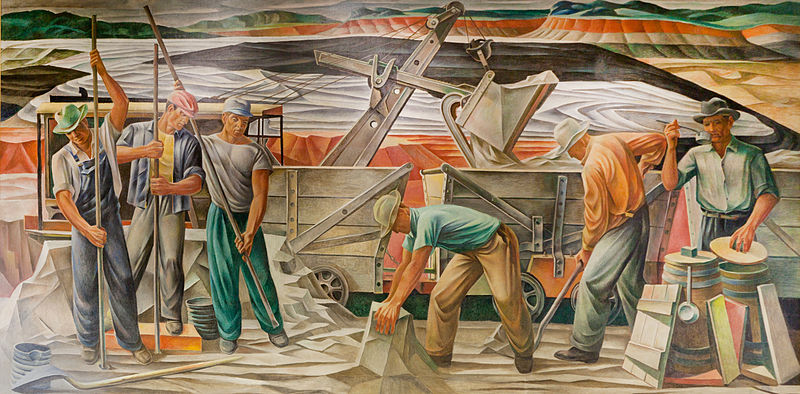
Our Shared Spaces a Sort-of-Critique
by Danny R.W. Baskin
The art world of Northwest Arkansas is evolving. It grows with each year into a more dominant force and has been built into a source of pride for most of us in the area. Art walks, fresh galleries, and collaborative exhibitions abound from Bentonville on down. There are more artists moving in, staying, and finding funding. There are spaces to show and spaces to create, and we are all better for it. The aspect of this that is perhaps the most noticeable is the growth of public works: murals in our shared spaces.
These public works include not only pieces brought about by local city governments such as the bike trail murals, but also visiting professionals such as JUST KIDS, who curate the wildly popular The Unexpected project based in Fort Smith. These works also include electrical boxes and drainage systems, roadworks, privately-funded pieces on apartment buildings, and much more. Public art is growing in the area and everyone is an audience member whether they are willing to be or not.
Generally, I’m a big fan of public art. Any manner in which art is given to the public for free is a good thing. It gives people who might not have the time, money, interest, or knowledge base a direct way to experience contemporary visual art. It breaks up the monotony of the urban (or suburban) landscape. It provides a breath of fresh creativity when one least expects it. These are all good things. But while some art can be inspiring, other pieces can be distracting, disturbing, or downright offensive. What follows are some particular issues I’ve had with certain public works that I would like to bring direct attention to so that we might collectively force our public art to move in a more positive direction in the future.
One issue I see commonly in murals, not to mention within all sorts of art, is the ever-problematic semi-nude or sexualized female figure depicted from a hetero male perspective: the male gaze. I can’t dip too deeply into feminist theory here, but I suggest reading Laura Mulvey who coined the term “male gaze” in her 1975 essay, “Visual Pleasure and Narrative Cinema.” Basically, it’s a creepy move for some dude to paint an anonymous “sexy lady” for no reason at all. A woman as subject matter is fine, but is there a reason she’s shirtless or pouty lipped? Does she have anything to do with the rest of the mural at all or was “random sexy lady” the theme? Maybe in the future we can put a kibosh on this obviously problematic painting theme.
Another issue I regularly notice in some newer public works are potential driving hazards. The eye can’t help but be drawn away from the task at hand when zooming past a mural covered in bullseyes and neon-drenched arrows. The unknowing driver navigating downtown Fayetteville might not realize that the squiggly colored lines they see on the road are actually part of an art piece, rather than traffic directions. It’s a small issue, but one that should be at least contemplated for all public works.
A larger issue that is especially troubling is the act of depicting inappropriate cultural references in public works. Northwest Arkansas and the River Valley is covered in portraits of generic cowboys shooting cherub-winged bullets, Native Americans decked out in unrealistic warpaint, and arrows violently piercing the earth. The Trail of Tears runs through this whole area, and perhaps the work that we decorate it with could be a little more respectful of Native American lives and traditions. I realize that there are recent murals that are respectful and reflective of this history, but it bothers me to see even one that has such a blatant disregard.
What I want is more from our new public pieces. More effort, more specificity, more thoughtful curation, and more time for artists to submit ideas. I think of the magnificent post office murals around the country left behind from the New Deal, or Philadelphia’s Association for Public Art. There are many examples to look to, and many ways to grow.
We have funding, talent, and appreciation here. Let’s make our public works something to boast about.
*This essay was originally published in print in Parlor Issue #1.
*Cover Image: Julius Woeltz, The Bauxite Mines, 1942, mural, 73″ x 143 1/4″, located in the Saline County Courthouse in Benton, Arkansas, originally installed in the U.S. Post Office in Benton, Arkansas. Wikipedia,
